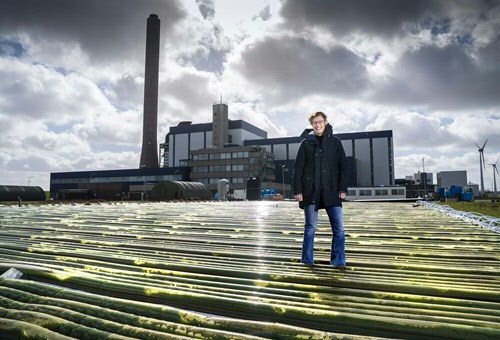Alumna Monique Schoondorp has developed a sustainable method of algae cultivation
Next to the Engie gas-fired power plant in Eemshaven, algae slosh against the sides of long, transparent airbed-like ‘tanks’. The green water rises and falls to the rhythm of the air pumps. Harvestable algae flow naturally over a weir into the harvesting tube. The algae, which double in size every 24 hours, are harvested daily. The high proportion of proteins and omega fatty acids makes algae attractive for a host of applications, from cosmetics to food for humans and animals. ‘Organic farmers, for example, are eager for remedies against diseases,’ explains Monique Schoondorp. ‘Algae contain substances that prevent the growth of fungi. And companies that want to reduce their CO2 emissions can do so in a cost-effective way with algae farms.’
Benefits of algae cultivation
Schoondorp, a UG graduate with a PhD in Chemistry who then headed innovation consultancy Nonagon, was approached in 2007 by the Province of Groningen to investigate algae’s potential for the Northern Netherlands. This opened up a whole new world for her. ‘Algae was a big hype back then, especially in the US. My conclusion was that we had to start working on it too.’ Schoondorp, co-director of Omega Green, outlines the benefits of algae cultivation: ‘Algae absorb CO2, they produce their proteins much more efficiently than any other crop and you can use algae to make a wide range of new products.’

Patent
Schoondorp launched the company a year later with business partner Bert Knol. To cultivate algae, they developed a patented flat plastic water bag. Weirs create five 20-metre long tubes of which the sides are in contact with each other. Schoondorp: ‘That distributes the nutrients over 900 litres rather than in separate tubes containing a fifth of that volume. This is essential because the greater the volume in which the nutrients can be distributed, the better the algae grow.’
Neutralizing CO2
‘The weirs also ensure that the water is no deeper than seven to ten centimetres, otherwise the light wouldn’t penetrate and the algae wouldn’t grow.’ Water that contains nutrients (phosphate and nitrate) and air containing CO2 go into the bag at one end and algae come out the other end, with water and oxygen as residual streams. The pH level of the water determines the amount of CO2 that is introduced: ‘The CO2 makes the growing environment more acidic but because the algae consume the CO2, the pH level rises again. At a particular pH level, new CO2 is automatically added. That way we can boost growth.’ Once power consumption and transportation, etc., are deducted, the result is that algae neutralize up to 1.4 kilos of CO2 per kilo of dry matter produced.
Working with students
Schoondorp enjoys working with the University of Groningen. The automated supply of CO2 was developed in collaboration with the Department of Marine Biology, which also regularly supplies her with new, clean starter cultures to prevent the algae from becoming contaminated with microorganisms. Omega Green is also carrying out research with Master’s students on the growth of algae. They are investigating which nutrient mix produces the most omega fatty acids, how much light the algae need and whether the air pump should operate quicker or slower.
First algae farm in the Netherlands
Following the construction of algae farms in Morocco and Germany, Schoondorp hopes to start building the first commercial algae farm in the Netherlands (in the province of Friesland) this year. She sees this as the start of something bigger. ‘In Groningen, we have the potential to become “Algae Valley”. We have lots of power plants and industry here – and therefore CO2 production – but there’s also a lot of space for cultivation, as well as knowledge institutions that can use it to make innovative products.’
This article has been taken from our alumni magazine Broerstraat 5. Text Bert Platzer / Photo Reyer Boxem
More news
-
15 September 2025
Successful visit to the UG by Rector of Institut Teknologi Bandung
